Doce tribus de Israel
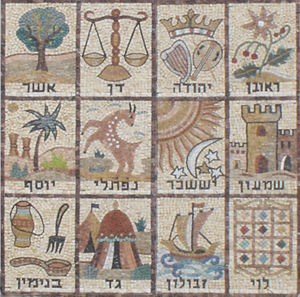
Se suele considerar que la historia de las doce tribus de Israel comienza con Abraham, el progenitor y primer patriarca del pueblo hebreo. Pero en realidad su historia en la Tierra comienza mucho antes, con la venida de Sanat Kumara, el Anciano de Días, que llegó en una misión de rescate en el momento pésimo y más oscuro de la historia de la Tierra.
El Consejo Cósmico que gobierna el destino de la Tierra decretó la disolución del planeta y sus evoluciones, porque todas las personas de la Tierra habían olvidado el Origen y la llama trina.
En ese punto, Sanat Kumara, jerarca de Venus, acudió al Consejo Cósmico y dijo: «Me ofrezco a ser el salvador de la Tierra. Me ofrezco a guardar la llama de la Tierra hasta que haya alguien entre los hombres que despierte hacia el conocimiento de la Ley». Sanat Kumara recibió la oportunidad de venir a la Tierra a guardar la llama.
The incarnation of the lightbearers
Cuando los portadores de Luz de Venus, Mercurio y otros hogares planetarios se enteraron de que Sanat Kumara se había ofrecido para defender las evoluciones de la Tierra, ellos se ofrecieron a ir con él; y fueron aceptados. Y así, cuando Sanat Kumara llegó a la Tierra, con él llegó un séquito de portadores de Luz para establecer Shambala, su retiro en la Isla Blanca del mar de Gobi (que ahora es el desierto de Gobi, en China).
Quienes vivieron con Sanat Kumara debían encarnar de acuerdo con un destino prestablecido entre las naciones de la Tierra. Su misión era ser portadores de Luz que enseñaran a la humanidad el camino de la Trinidad, el camino de la llama trina, el camino del fuego sagrado y que le recordaran su origen. Así, debían llegar a Oriente y a Occidente y debían venir a enseñar a los hombres el camino del Padre y el camino de la Madre.
En Occidente, los portadores de Luz que encarnaron para servir a la luz son conocidos como las doce tribus de Israel. En Oriente, ellos forman las escuelas de misterios que siguen la tradición del Gurú y el chela. En cada caso, este grupo de almas tiene la finalidad de transmitir, de generación en generación, en una cadena íntegra con su inicio en Lemuria, las verdaderas enseñanzas de la religión del Padre y la religión de la Madre.

Las doce tribus: progenie de Sanat Kumara y Abraham
En Occidente, la evolución de las doce tribus en la tradición judeocristiana ha sido una historia de desobediencia y castigo y luego redención. En el Antiguo Testamento hay una historia sobre el juicio al pueblo de Israel que se produce una y otra vez a través de evoluciones rezagadas.
La búsqueda en Occidente se ha centrado en torno a la meta de encontrar la gracia ante los ojos de Dios al encontrar al Cristo, el Mediador, y llegando a ser amigos de Dios, como lo fue Abraham a través de ese Cristo.[1] Este sendero se cumple en la persona de Jesucristo.
La historia escrita sobre estos portadores de Luz en Occidente, las doce tribus de Israel, comienza en la Biblia, en el Génesis, capítulo 12, cuando Dios promete la bendición a Abraham: «Y haré de ti una nación grande, y te bendeciré, y engrandeceré tu nombre, y serás bendición»[2].
En el capítulo 15, Dios dice a Abraham (cuando aún se lo conocía como Abram): «Mira ahora los cielos, y cuenta las estrellas, si las puedes contar. Y le dijo: Así será tu descendencia»[3]. Entonces Dios le dijo a Abraham que hiciera un sacrificio. Él así lo hizo y Dios les habló de un karma que le sobrevendría a su progenie:
Mas a la caída del sol sobrecogió el sueño a Abram, y he aquí que el temor de una grande oscuridad cayó sobre él. Entonces el SEÑOR dijo a Abram: Ten por cierto que tu descendencia morará en tierra ajena, y será esclava allí, y será oprimida cuatrocientos años. Mas también a la nación a la cual servirán, juzgaré yo; y después de esto saldrán con gran riqueza. [Esta es una profecía sobre el cautiverio de las doce tribus en Egipto].
Y tú vendrás a tus padres en paz, y serás sepultado en buena vejez. Y en la cuarta generación volverán acá; porque aún no ha llegado a su colmo la maldad del amorreo hasta aquí.[4]
Sanat Kumara eligió a Abraham como padre de los israelitas, el cual recibiría, en su vejez, gracias a Sarah, a su hijo Isaac. Isaac a su vez tendría a Jacob. Jacob traería al mundo a doce hijos, que serán los progenitores de las doce tribus.
Así, Abraham es el gran patriarca de los portadores de Luz, elegido para traer a la progenie de Alfa. Estas almas llegaron con la misión específica de ser testigos del Dios verdadero en medio de la idolatría, en medio de la gran oscuridad de Oriente Próximo, como la que se vio en Sodoma y Gomorra. Llegaron para ilustrar la bienaventuranza de servir a Dios, de recibir y conservar la profecía y las revelaciones y, sobre todo, ser el canal a través del cual naciera el Mesías.

Los doce hijos de Jacob
En 1900 a. C. aproximadamente Dios confirió su bendición a Isaac, hijo de Abraham: «Y se le apareció el SEÑOR esa misma noche y dijo: “YO SOY el Dios de tu padre Abraham; no temas, porque estoy contigo, y te bendeciré, y multiplicaré tu progenie por mi siervo Abraham”»[5]. Es muy curioso que el SEÑOR bendiga a cada generación de portadores de Luz, lo cual significa que la bendición no se produce de forma automática con la transferencia hereditaria, sino que llega a partir de su restablecimiento para cada generación.
El hijo de Isaac, Jacob, recibió a su vez la bendición del SEÑOR muchos años después y otra bendición cuando luchó con el ángel, el Arcángel Miguel, quien lo purificó de su mal permitiéndole así recibir la unción del nombre «Israel».[6]
Jacob tuvo doce hijos, nacidos de sus cuatro esposas. Estos fueron ungidos por Sanat Kumara como portadores de la progenie de luz para el cumplimiento final del destino de los portadores de Luz. Su hijo favorito fue el undécimo, José, a quien le hizo una túnica de diversos colores. Esta túnica es el símbolo del Cuerpo Causal de los hijos de Israel. Jacob eligió a José para que llevara esa túnica porque vio que este tenía la mayor manifestación de la conciencia Crística y que podía llevar la llama de la mezcla de todos los rayos de colores del Cuerpo Causal. José, por tanto, recibió su derecho de nacimiento de su padre, Israel.
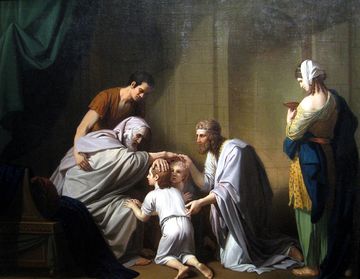
Pero los hermanos de José sintieron celos de él. Primero planearon matarlo, pero después decidieron venderlo como esclavo. José fue llevado a Egipto, donde se ganó la confianza del Faraón y llegó a ser su mano derecha. Cuando la sequía y el hambre acosaron la tierra, Jacob y sus once hijos fueron a Egipto en busca de alimentos. José les reveló su identidad y la familia volvió a estar unida. Los doce hermanos volvieron a estar unidos como un solo mandala. Como muestra de su amor por José, Jacob tomó consigo a sus dos hijos, Manasés y Efraín.
Los doce hijos de Jacob son Rubén, Simeón, Leví, Judá, Isacar, Zabulón, José, Gad, Aser, Dan, Neftalí y Benjamín. Los descendientes de cada hijo se convirtieron en las doce tribus y cada una de ellas asumió el nombre de su patriarca. En las primeras listas se nombra a José como una de las tribus. En listas posteriores se omite a Leví y se sustituye a José por sus hijos, Efraín y Manasés. Así es como Leví se convirtió en la decimotercera tribu, la que está en el centro del círculo ocupando el cargo de Cristo y la llama del sacerdocio.
Antes de morir, Jacob dio su última bendición a sus doce hijos y les dio una profecía sobre las tribus y su destino. Esto consta en el Génesis, capítulo 49.
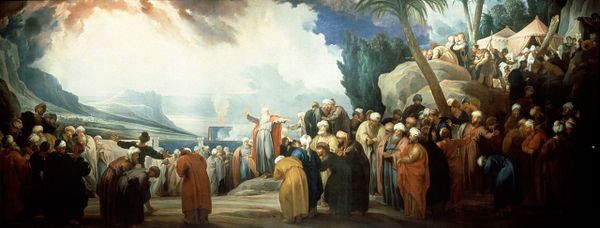
Advertencia y bendición a las doce tribus
Tras muchos años, los descendientes de los hijos de Jacob que vivían en Egipto se multiplicaron hasta tal punto, que el Faraón se sintió amenazado por su cantidad y su poder. Los esclavizó y ordenó que todos los varones hebreos fueran ahogados al nacer.
Moisés nació durante esta peligrosa época, pero su madre le salvó la vida poniéndolo a flotar en el Nilo en una cesta. La hija del Faraón lo encontró y lo crio como a un hijo propio. En respuesta al llamado de Dios, Moisés condujo a su pueblo desde Egipto hacia la Tierra Prometida. Tras cuarenta años vagando por el desierto, los hebreos, bajo el liderazgo de Josué, entraron y conquistaron la Tierra Prometida, la tierra de Canaán.
Antes de marchar, Moisés da una bendición y una advertencia a estas doce tribus y entrega la antorcha a su chela, Josué. Con esas palabras de despedida, Moisés los reprende y profetiza que, aunque les ha advertido que caminen con rectitud y elijan la vida y no la muerte, tropezarán; se volverán tercos; olvidarán sus palabras en cuanto se haya marchado. Estas palabras constan en el último capítulo del Deuteronomio.
Moisés les advirtió que no se mezclaran con las naciones vecinas, dándose a sus Dioses, casándose con su gente. Esas naciones vecinas pertenecían a los Néfilim y los caídos. Y Moisés predijo que se llegarían a asociar con ellos, que seguirían sus caminos y su idolatría. Él predijo que, si lo hacían, eligiendo así su culto de muerte, les sobrevendrían las maldiciones del SEÑOR; es decir, que les sobrevendría el juicio o karma por sus acciones.
Al final del escrito se encuentra la bendición de Moisés a las doce tribus antes de que falleciera. En esto se observa el gran amor de Sanat Kumara a través de Moisés hacia cada una de las doce tribus. Anteriormente está la reprimenda y la afirmación de su karma y sus defectos, pero en esta bendición todos son elogiados. También hay una profecía sobre lo que llevarán a cabo. Estas profecías están ocultas y se basan en el simbolismo. El sello de esa bendición contiene el plan divino y la oportunidad de conseguir la victoria para cada una de las doce tribus, sosteniendo cada tribu una línea de los doce puntos de nuestro reloj cósmico iniciático.
Moisés fue el Gran Gurú de las doce tribus de Israel. Actualmente vivimos en un momento en que todas las promesas de Dios a través de los profetas para restaurar la memoria de las tribus y para restaurar la Tierra Prometida está a punto de cumplirse; profecías acerca de la transmutación del karma formuladas con las palabras: «Y nunca más me acordaré de sus pecados»[7].
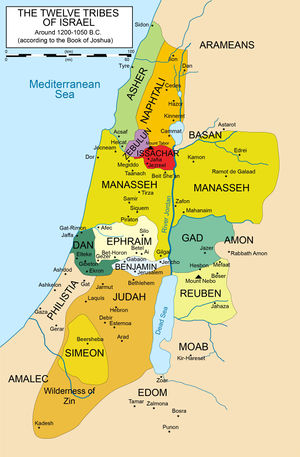
The dispersion
Joshua divided the conquered territory among the tribes according to God’s direction. The only tribe that did not receive territory was the tribe of the Levites. The Levites led the people in worship, were responsible for teaching God’s Law and performed other religious functions. The twelve tribes formed a loosely knit confederacy bonded together by their religious covenant with God. They were each in charge of their own territory, but in time of crisis they banded together to fight a common enemy.
Después de que falleciera Josué, las tribus fueron dirigidas por jueces. Estos eran principalmente líderes militares carismáticos levantados por Dios para defender al pueblo contra las intrusiones de las naciones vecinas.
Durante el período de los jueces, entre 1200 y 1030 a. C., los israelitas empezaron a rendir culto a dioses paganos, los dioses del materialismo, los dioses de los ángeles caídos. Dios los castigó por su idolatría y su apostasía permitiendo que otras naciones los hostigaran y atacaran. Esos invasores se apoderaron de sus tierras y sus campos de cultivo y les exigieron tributo.
Cuando los israelitas se arrepintieron y obedecieron las leyes de Dios, el SEÑOR otorgó poder a los jueces para que defendieran su causa, y así volvieron a disfrutar de paz. El patrón de desobediencia y castigo, arrepentimiento y liberación se repitió una y otra vez. El liderazgo de los jueces se terminó cuando el pueblo le exigió a Samuel, último juez de Israel: «Queremos que nos gobierne un rey para ser como las demás naciones»[8]. Los israelitas creían que su confederación tribal no era suficientemente fuerte para protegerse de la amenaza de los ejércitos filisteos.
Samuel le dijo al pueblo que su deseo de tener a un rey suponía un rechazo a Dios. De hecho, demostraba que su sintonización con la Presencia de Dios viva que los acompañaba había disminuido y que habían olvidado la constante liberación que Dios le había proporcionado manifestándose ante ellos a través del Arcángel Miguel, el Arcángel Gabriel y todas las huestes celestiales. Y así, buscaron poder en un ser humano, un líder y un rey.
Samuel accedió a sus exigencias a regañadientes ungiendo a Saúl como rey, pero les advirtió que una monarquía les oprimiría. Cuando Saúl murió, David llegó a ser rey de Israel después de un corto período durante el cual el hijo de Saúl gobernó sobre las tribus del norte. Salomón sucedió al trono a su padre, David, y aunque trajo prosperidad y paz al país, también sobrecargó al pueblo con impuestos y esclavitud.
Poco después de la muerte de Salomón, aproximadamente en 922 a. C., las diez tribus del norte se rebelaron contra el hijo de Salomón y heredero al trono, Roboam. Estas tribus formaron su reino, llamado Israel, gobernado por su propio rey. Las tribus de Judá y Benjamín formaron el reino del sur, más pequeño y pobre, llamado Judá.
Durante unos cincuenta años después de la división del reino, Israel y Judá tuvieron una guerra civil por la demarcaciones territoriales. En parte como resultado de sus peleas, los dos reinos perdieron territorio, del que se apoderaron las naciones vecinas. En los siglos que se sucedieron, Israel y Judá se volvieron más y más vulnerables debido a sus recaídas. El profeta Oseas, predicando en el reino del norte, denunció la creciente corrupción social, el culto a los dioses paganos y el declive moral. Les advirtió que habían violado su alianza sagrada con Dios y que tendrían que pagar por ello.
En 721 a. C. los asirios, bajo Sargón II, conquistaron el reino del norte de Israel y forzaron la deportación de la mayoría de la gente a Asiria. Esto supuso el fin del reino del norte. Debido a que el destino de las diez tribus del norte es desconocido, se las denomina como las diez tribus perdidas. La creencia generalizada es que jamás regresaron a su patria.
Con la desaparición del reino del norte, Judá se convirtió en vasallo de Asiria. Después, en el siglo VII a. C., se convirtió en vasallo del Imperio babilonio. Durante este período turbulento, el profeta Jeremías predicó el inminente juicio de Dios sobre Judá por su pecaminosidad. Jeremías les advirtió que, si el pueblo no se volvía completamente hacia su Dios, encontraría el mismo destino que Israel a manos de un «mal del norte»[9].
Judá, como Israel, era culpable de idolatría, apostasía, corrupción y degeneración moral. Habían erigido altares llenos de dioses ajenos a los que rendían culto junto al SEÑOR. La prostitución sagrada del culto a la fertilidad se practicaba en el Templo de Jerusalén. Algunos incluso participaron en la práctica pagana del sacrificio humano, haciendo «pasar por el fuego sus hijos y sus hijas a Moloc»[10].
La profecía que el SEÑOR pronunció a través de Jeremías se cumplió. El rey de Judá se rebeló contra los babilonios y en 597 a. C. el rey babilonio Nabucodonosor sitió Jerusalén y deportó al rey junto con los líderes de Judá.
En 587 a. C. los babilonios destruyeron Jerusalén totalmente, saqueando, quemándolo todo, hasta el Templo, y deportando a todo el mundo excepto unos pocos habitantes. En 582 a. C. se produjo otra deportación. Aunque se les había arrebatado su tierra, las condiciones de los exiliados no eran desfavorables. Los judíos se hicieron agricultores, mercaderes, comerciantes, soldados, incluso funcionarios del gobierno, alcanzado algunos la riqueza.
La venida del Mesías
En 538 a. C. el rey persa Ciro, conquistador de Babilonia, emitió un decreto con el que permitía a los judíos regresar a Jerusalén y reconstruir el Templo. La mayoría de ellos habían olvidado y no les importaba su herencia. Solo regresó un pequeño remanente de las tribus, la mayoría de sus componentes pertenecientes a las tribus de Judá y Benjamín. Se llevaron consigo los recipientes del templo que les habían quitado en 587 a. C. y reconstruyeron el templo de Jerusalén.
Este período fue de preparación para la venida del Mesías. Ahora comprendemos que la preparación para la venida de Jesús había comenzado con Sanat Kumara, Abraham, Isaac, Jacob y sus doce hijos. Pero ¿qué les sucedió?
En aquella época, vivía en Egipto y en la Media Luna Fértil un conglomerado de gentes. Algunas rendían culto a Baal y a Astarot. Era una generación rezagada, descendientes de la Atlántida. Eran los que condenaron a los profetas, los que rechazaron a Noé, los que se mofaron de él.
Y en medio de esos rezagados que habían llegado de otras esferas, que se habían quedado atrasados en sus evoluciones planetarias, ahí nació un pueblo de gran luz, el pueblo que había venido con Sanat Kumara, gente que pertenecía a las huestes angélicas. Todos se mezclaron en la Media Luna Fértil, y los grandes patriarcas y los profetas intentaron constantemente separar a la gente de luz de la gente de la oscuridad. Incluso recibieron el decreto que les prohibía unirse en matrimonio con quienes veneraban ídolos y a otros dioses. Y continuamente les recordaban quién era su Dios.
Pero ellos no hicieron caso de sus instructores y profetas. Se mezclaron la progenie de luz y oscuridad; exactamente lo mismo que vemos actualmente en todas las naciones de la Tierra. La Serpiente los venció. Pecaron. Se rebelaron contra Dios. Por tanto, les faltó la comunidad y el foco físico de la Gran Hermandad Blanca.
Lo que quedó fue un remanente muy pequeño de portadores de Luz; y así, en vez de llegar al reino de Israel, Jesús nació bajo el Imperio Romano. Al sufrir la inmediata persecución de Herodes, él y su familia tuvieron que huir a Egipto.
Jesús vino como un avatar solitario y tuvo que enfrentarse a toda Babilonia como Iglesia y a toda Babilonia como Estado. Se enfrentó al sacerdocio que había invadido al pueblo de Israel, que había destruido la verdadera esencia de la enseñanza de Moisés y Sanat Kumara.
Debido a que ya habían perdido su verdadera raza y se habían mezclado con los pueblos de Canaán y de la Media Luna Creciente, la mayoría de las doce tribus habían puesto en peligro su conciencia Crística, que les habían dado los profetas. Por tanto, no reconocieron al Cristo en Jesús.[11]
Sin embargo, él vino. Y cuando levantó a sus apóstoles y les dio su manto para que fueran tras las ovejas perdidas de la casas de Israel, les estaba enviando a encontrar a los portadores de Luz de las tribus perdidas, aquellos que habían perdido su identidad, habían olvidado quién eran y estaban esparcidos por doquier. Los envió a través de Asia Menor. Llegaron hasta India e Italia. Por todo el mundo conocido fueron en busca de los portadores de Luz.
Las doce tribus en la actualidad
¿Qué fue de las doce tribus? Después del ministerio de Jeremías, se esparcieron por la faz de la Tierra.
Las diez tribus del norte han reencarnado entre los llamados Gentiles. Algunos estudiosos han querido seguir la pista de la migración física de estas tribus a Europa, Rusia y las Islas Británicas. Estudian el origen de los escudos y blasones familiares de las distintas ciudades y estados de las doce tribus, cuyos emblemas se derivan de la última bendición que Jacob dio a sus hijos. También consideran que las profecías de Jacob y Moisés acerca de las varias tribus se han cumplido en la historia de las distintas naciones europeas.[12] Tanto si estos estudios demuestran ser válidos gracias a un linaje físico como si no, no sabemos si las tribus permanecieron intactas como mandala a nivel del alma. Las tribus han ido descendiendo, muchas de ellas siguiendo la fe cristiana, aceptando al Mesías, pero olvidando su origen como miembros de esas diez tribus.
Las tribus de Judá y Benjamín, en el sur, y algunos de los levitas que estaban con ellas recordaban que eran judíos, pero no percibieron el cumplimiento de la profecía de la venida del Mesías.
Los miembros de las doce tribus son las legiones de Sanat Kumara. Han llevado la llama de la verdadera Israel por todas las escuelas de misterios, en Cámelot, en la escuela de Crotona, en los ashrams de India y Asia. Allá donde ha habido un núcleo de portadores de Luz y el reconocimiento del Origen y el Mediador (el YO SOY EL QUE YO SOY y el Cristo), allá ha tenido lugar la reunión, de nuevo, de los Israelitas diseminados por la faz de la Tierra como progenie de Abraham, que se convirtió en la progenie del Cristo a través de David.
La Biblia es un escrito sobre cómo triunfaron y fracasaron esas almas que vinieron a través de Abraham. Las doce tribus tienen un trabajo que hacer y nacen para lidiar con una energía determinada. Vemos que su fracaso a lo largo del Antiguo Testamento hasta su dispersión final se basa en el hecho de que no han emprendido y realizado este trabajo.
Habiendo heredado el karma de las doce tribus, este es el karma que tenemos actualmente. Como portadores de Luz, aquellos que llevan la semilla de luz, tenemos la responsabilidad de transmutar todo lo que consta en el Antiguo y el Nuevo Testamento.
Hoy, nuestra misión es comprender quiénes somos, dónde encajamos en el mandala de estas doce tribus y, luego, saldar el karma en que han incurrido las doce tribus. Al saldar ese karma con la llama violeta, con invocaciones, eliminaremos los campos energéticos, las islas de oscuridad que mantienen separadas a las doce tribus y también a los miembros de cada tribu. La carga de este karma es la razón por la que las tribus no tienen un sentido de identidad propia hoy día; y los verdaderos miembros de las tribus no tienen ninguna idea de quién son.
Jesucristo encarnó para buscar a las ovejas perdidas de la casa de Israel, aquellos que habían perdido la memoria de haber pertenecido a la luz de Sanat Kumara. Y nosotros, hoy, somos un remanente de esas tribus. Los portadores de Luz que encarnan en todas las épocas en Oriente y Occidente son los mismos miembros de las doce tribus de Israel.
Old Testament prophecy, then, is our heritage. Coming out of Egypt, crossing over the Red Sea, going into the Promised Land and then being disobedient and being chastised—all of this is what we have gone through collectively in our incarnations of the West.
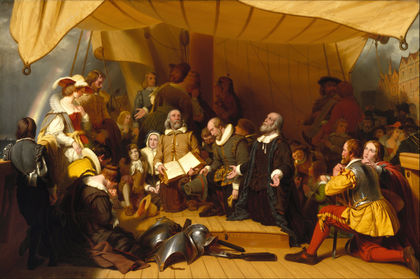
The New World: promised land for the gathering of the twelve tribes
As we trace the history of the reincarnated tribes, we find a very special destiny for the sons of Joseph and the two tribes of Ephraim and Manasseh. These two sons of Joseph, having the highest blessing, the very personal blessing of Jesus Christ in the person of Joseph, having his seed, are the ones called to reverse the sin of the other brothers of the house of Jacob. The other brothers had great sins in their day and unto the present hour.
We also see in Joseph that he married the daughter of an Egyptian priest, and therefore the seed of Egypt and of the ancient Pharaohs, even coming down from Ikhnaton and Nefertiti and the religion of monotheism, is among these particular tribes. They went to the British Isles and became the nucleus of the English-speaking people in Britain, America and the world.
It was given to them to carry the cup of the Christ consciousness and to bring the English language all over the world through colonization and through discovery, so that when the teachings of the I AM THAT I AM would be given again to the children of Israel, they would come through the English language, the language chosen because it most nearly reflected the angelic tongue that is the source of the original teaching to the original people of Israel. So it was the destiny, then, of the English-speaking peoples to carry that Christ consciousness to the new world.
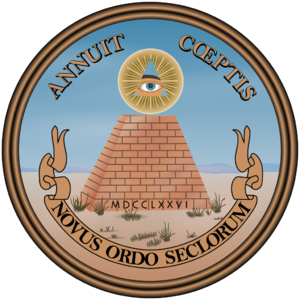
The new world, America, is the land that was promised by the LORD God to the children of Israel. They were told that they would be brought into a new land and would be given a new dispensation. Early records in the history of the nation show that the founding fathers of America knew that they were the people of Israel, that they were the inheritors of this promise and that they had come to a new world to found the New Israel, the New Jerusalem, the new mystery school, the new place of dispensation. We see this symbolized in the Great Seal of the United States, with the All-Seeing Eye of God in the capstone of the pyramid, focalizing the mission of the twelve tribes.
Even in the name, America, there is revealed the origin and destiny of the nation. The letters of the name, when rearranged, spell I AM Race. This is the race of the children of Israel who have accepted their God-reality, who know God as the I AM that was revealed to Moses.[13] They have been called to America as the gathering together of the elect from the four winds,[14] from the four corners of the earth, to bring forth the Christ consciousness and then to take that Christ consciousness to every nation. This is the mission of the Israelites in the United States, founded upon the mystery school of the thirteen—thirteen founding states, Christ and his apostles.
So we see the emigration, vast lines of pilgrims, first from the British Isles, the brothers Manasseh and Ephraim, and then from the tribes of all the different European nations becoming the foundation of the United States.
Tracing the seed of light
We go back, then, to the very history of Jacob and the coming of the twelve tribes to discover our own history. As we understand our history, we understand our blessing. When we study the promises of the prophets and the patriarchs to us, then, when we give our invocations, we are standing upon the rock of Christ, and we have the confirmation of the Word through the flame of the ark of the covenant.
These tribes have a destiny to fulfill. That destiny is to unite under the banner of the I AM THAT I AM—the Presence of God individualized in each one of us in whom there burns the flame of God. Through the Spirit of the living Christ, we are destined to become a major world power.
The twelve tribes of Israel today are not a lineage of twelve tribes by blood, but their descent can best be explained by reincarnation. The seed of Abraham was scattered. They continued to reembody, always carrying that seed, and therefore, they may not be in bodies that resemble the Semite people. They may very well be Chinese or African or Indian or any race. But they have come again.
The seed that they carry is the nucleus of the Christ consciousness. All who have the Christ consciousness are of this seed. And you find that there is a dividing line. You find people of every religion who deny that Flame, that essence, that Spirit, and deny the opportunity for the individual to become that Christ. Others have known from the beginning that they were Christ, they were that Flame, they were that Reality. Others have known it by another name and have intensely resisted the name Christ, but when they understand the true meaning, then they realize that that is the indwelling Presence with whom they, also, have communed.
In the seventh chapter of the Book of Revelation, we read the prophecy of the sealing of the servants of God in their foreheads, twelve thousand from each of the twelve tribes, a total of 144,000. They also appear in chapter 14 as those gathered around the throne of the Lamb, who is Sanat Kumara. And so, in Revelation there is a continuing chronicle of the twelve tribes and of their overcoming of all that is revealed.
Our destiny as the twelve tribes
The twelve tribes of Israel have not maintained a continuous identity over these thousands of years. But our great victory lies in the fact that the identity is in the Inner Flame; no one can take from us the flame of light, the Flame of God, the original Word, the memory of the teachings of East and West, the instantaneous rapport with the I AM THAT I AM and the recognition that Christ was not alone in Jesus but that he is in us. When you find people that have that awareness, you are finding the members of the house of Israel and Judah.
The genius of the twelve tribes is in every nation. All of the nations are forcefields for the development of the Christ consciousness through the twelve tribes, and each of the nations of the earth is an opportunity for the lightbearers to master a certain initiation of a certain chakra.
We find today that the twelve tribes have been caught up and lost their identity as the tribes of Israel and have identified themselves now within their many nations. They have not realized that they have put on their nationhood to identify in that nation, to set the example of the lightbearer to the people. The Ascended Master Saint Patrick has come to help us make contact with the lightbearers of all nations, to alert them to the message, to alert them to the teachings of the ascended masters, to bring them together so that they can form the nucleus for the victory and the salvation of earth. Until we make this contact, identify our brotherhood, identify our community, we do not sense our strength.
He has said:
I AM the defender of the Woman in this age. I come, then, to secure a place for her children—children of the Mother who have come out of the land of Israel so long ago that they have forgotten their source and their common origin as the seed of Abraham, of David and of Christ, the Messiah of all.
I come, then, to deliver the mandate of truth, and it is this, that the children of the light must be one, that all who have gone forth out of the nucleus of the sacred fire of Jerusalem to the four corners of the earth now are called to be sons and daughters of God. And yet they remain as prisoners of their respective nations—prisoners in the sense that they are bound by certain customs and laws and political and religious ideologies, whereby they have forgotten the one true law of the I AM THAT I AM.
I center, then, the energies of the fiery core of my being here in the heart of the city, the New Jerusalem, and I place the magnet of my devotion to the Mother for the calling in of the rays of the house of the LORD, the rays of Ikhnaton, who saw the one God and the people of God as one, the rays that will call back the one hundred and forty-four thousand flames of the twelve tribes of Israel....
All of this warfare and this division that has been created as the divide-and-conquer tactic of the fallen ones, even midst the brethren of Ireland and of the British Commonwealth of Nations and throughout Europe and the Eastern countries, all of this is to this one purpose, children of the Light—now understand it is to keep the children of Israel separate and apart in the last days.
For in every nation there are lightbearers. But the fallen ones and those who have never elected to be one with the light of God, these live also among these nations. And the children of God, instead of identifying with the life and the Body and the Blood of Christ, have begun to identify themselves as members of these nations. And therefore, they see their national loyalties as greater than their loyalty to the one purpose of the Ancient of Days, Sanat Kumara, which was to keep the flame of life for the evolutions of this earth.
See, then, that you understand that for the defense of the karma and the dharma of the people among whom you have embodied, you must call yourself an American, an Italian, a Chinese or a Russian, but for the purposes of the salvation of earth, you must understand yourselves as the deliverers of the nations.
The cutting free of the nations by the action of your sword of life is your mission and your goal. It is to free the nations to behold within themselves, and not to come under, then, the boot and the darkness of those who proclaim a one-world government and yet do it not in the name of Christ, but in the name of a scientific humanism.
They do err, and their divide-and-conquer tactics have taken a new course in this age. It is to play upon the reality of the inner understanding of the people of God that indeed the earth is one, and to carry that understanding into a perversion whereby the karma and the dharma of the people of the nations is destroyed as they are forced to come into a totalitarian system whereby they are divested of their natural genius and their calling from the mansions of the Father’s house....
See also
Sources
Mark L. Prophet and Elizabeth Clare Prophet, The Path of Brotherhood, pp. 123–50.
- ↑ Santiago 2:23.
- ↑ Génesis 12:2
- ↑ Génesis 15:5.
- ↑ Génesis 15:12-16.
- ↑ Génesis 26:2-5.
- ↑ Génesis 32:24-28.
- ↑ Hebreos 8:12.
- ↑ 1 Samuel 8:5.
- ↑ Jeremías 4:6.
- ↑ Jeremías 32:35.
- ↑ The essence of the original teaching of Moses and Sanat Kumara was kept by the Essene communities, who were only a small minority in the Holy Land. Jesus’ parents were part of this community, which provided the spiritual cradle for Jesus’ incarnation. It is believed by many scholars that the early Christian community grew out of the Essene community.
- ↑ Véase por ejemplo Raymond Capt, Jacob´s Pillar (La columna de Jacob) (Thousand Oaks, Calif.: Artisan Sales, 1977); Colonel J. C. Gawler, Dan: Pioneer of Israel (Dan: Pionero de Israel) (Thousand Oaks, Calif.: Artisan Sales, 1984).
- ↑ Exod.3:14.
- ↑ Matt. 24:31; Mark 13:27.
- ↑ Saint Patrick, April 3, 1977.
